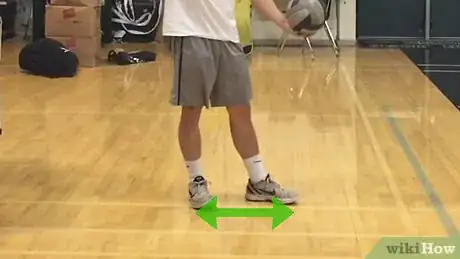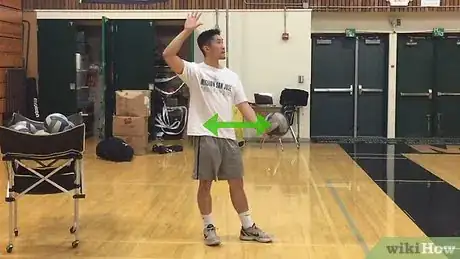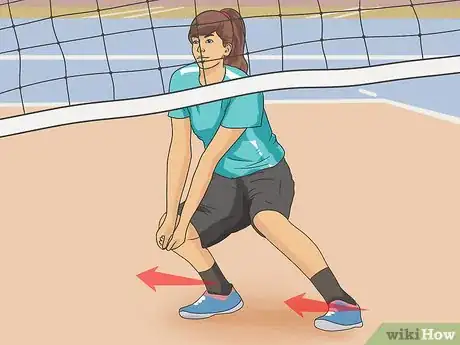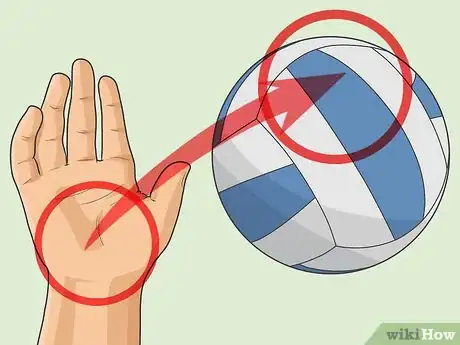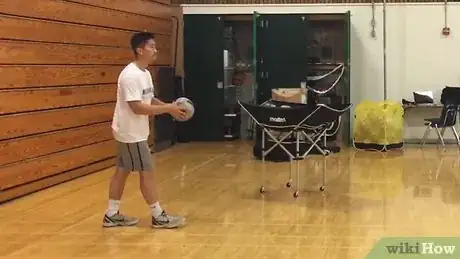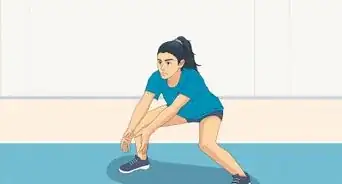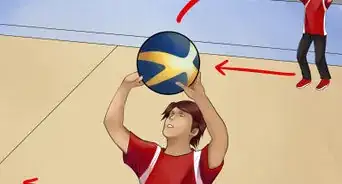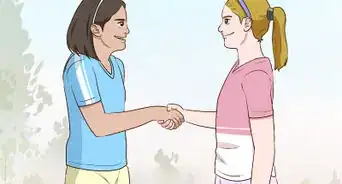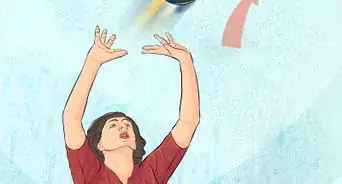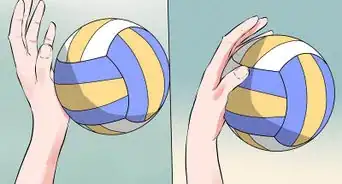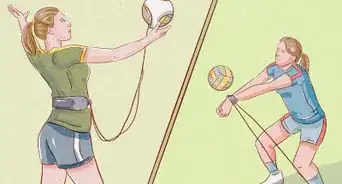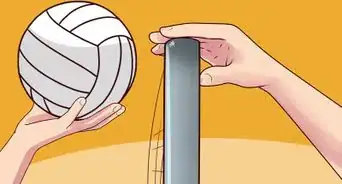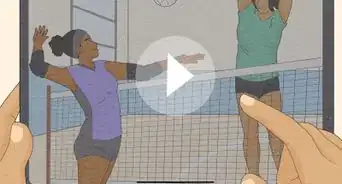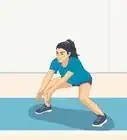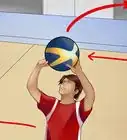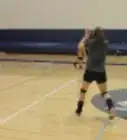This article was co-authored by Cynthia Barboza. Cynthia Barboza was a member of the USA Women's Volleyball Team for 10 years. She spent 4 years as the outside hitter for Stanford University and played professionally in Japan, Russia, and Italy.
wikiHow marks an article as reader-approved once it receives enough positive feedback. This article received 19 testimonials and 81% of readers who voted found it helpful, earning it our reader-approved status.
This article has been viewed 1,144,356 times.
Most of us have seen someone do an overhand volleyball serve that looked effortless. While an overhand volleyball serve is a more versatile serve, it's also more difficult. It requires more coordination, timing, and strength. Since this is a more difficult serve, you should practice it after you've mastered the underhand serve. While your overhand serve might not look effortless, it can improve the accuracy, speed, and power of your serves.
Steps
How to Serve With a Basic Overhand Serve
-
1Stagger your feet. Stand with your feet about shoulder-width apart. Place the foot opposite of your hitting hand in front of the other foot. Your shoulders and hips should be aligned with the net. Make sure your knees are bent. It is extremely important that your weight is on your back foot.[1]
- A server's posture is one of the most important parts of their serve. The power of the service isn't from upper body strength, but from the legs. A powerful serve is achieved by being able to transfer weight from the back foot to the front foot correctly. Getting a strong starting posture is pivotal to a strong serve.
-
2Hold the ball in front of you. Place your non-dominant hand directly in front of you, straight but with a flexible elbow. The palm should be face up with the ball in it.[2]
- Another way to set up is to cover the ball with your hitting hand.
Advertisement -
3Ready your hitting hand. Swing your serving arm back next to your head. Make sure that your elbow is pointing upwards and your hand is at or slightly above your ear. This stance opens your body.
-
4Toss the ball into the air. Lift the ball with your palm about 18–36 inches (46–91 cm) in the air. Keep the ball in line with your hitting shoulder and about 1 foot (0.3 m) in front of you so you can step into the serve. Your right hand should be at a 90-degree angle behind your body. Remember that you want your dominant hand to make contact with the ball just after it changes direction and begins to drop back down.
- Don't toss the ball too high, too low, or too far to any side. This means you will have to chase the ball, resulting in a bad serve.[3]
- In some variations, the hitting arm is readied as you toss the ball up, not before.
-
5Aim for your service with your body. The majority of the power of your service is gained from the legs as you transfer weight from your back leg to your front leg. To transfer your weight properly, make sure your starting position is correct. Add momentum by stepping forward with your dominant foot as you serve, transferring the weight forward for a powerful serve.
- The ball will go where your hand and toes face, so aim your palm and toes for accurate shooting.
-
6Hit the ball with the heel of your dominant hand. Lead with your elbow to bring your dominant hand forward. Smack the ball with the heel of your hand or the bottom of your palm.[4] Don't hit the ball with your fingers or fist. Make sure your serving hand is slanted slightly upward. This will help loft the ball over the net. Aim for the middle of the ball to achieve the straightest trajectory of the ball. Stop the motion of your hand when you make contact with the ball.
- Watch the spin on the ball. This will show you if you're contacting the ball correctly. If you see the ball sidespin or backspin, then you know your contact was off-center.
- Swing fast at the ball from the shoulder.
-
7Get into position. After striking the ball, use your momentum to run to your defensive position.
How to Serve With a Top-Spin Jump Serve
-
1Set up your stance. Begin with your feet shoulder-width apart facing the net. Your dominant arm should be directly in front of you, palm up, with the ball in your palm.
- You should be at least 5–8 feet (1.5–2.4 m) behind the line to have enough space for a 3-4 step approach.
-
2Toss the ball into the air. Step forward with your dominant foot and keep the toss in line with your hitting shoulder. As you step forward, throw the ball high into the air and slightly forward with your dominant hand. Flick your wrist when tossing the ball to create a spin on the ball.
- A consistent toss results in a consistent serve. The toss influences every aspect of the service; a bad toss can ruin an otherwise good serve. Toss with your strong hand, keep the ball in front of you, and don't throw it too high or low. These things result in bad serves.
-
3Take three or four quick steps forward. This should go slow to fast so that your last two steps are much quicker and should look like they're happening at the same time. On your last step forward, launch yourself into a jump. Use the momentum from the steps above to get higher in the air.
- If you're right-handed, your steps will be left-right-left. If left-handed, you'll be right-left-right. These last two steps are called a "step close" and are the most explosive part of your approach.
-
4Prepare your hitting arm. Both arms should swing back to generate power for the jump. As you jump, swing your dominant/hitting arm back behind your body at a 90-degree angle. As with the basic overhand serve, your elbow should be pointing upward, with your wrist rigid and at or slightly above your ear[5] . Your non-hitting arm should point at the ball to track it.
- Your non-hitting arm tracks the ball in what is commonly referred to as a bow and arrow movement.
-
5Learn how to hit the ball with your hand. Aim to hit the ball just above the center of the ball. Unlike in a basic overhand serve, don't stop your arm when you hit the ball. Swing all the way through and snap your wrist.
- If you can't get the snapping motion, practice. This wrist snap is what makes a top-spin serve powerful and unique. Practice perfecting the snap of the wrist along with hitting the ball correctly to send it sailing over the net.
-
6Hit the ball. Create lots of forwarding momentum by rotating your hips and body through the serve. You should be broad jumping into the court on your jump serve and jump float. At the highest point of your jump, bring your hand down in a snapping motion slightly underneath the ball. This way you can aim upwards, but wrap your wrist over the top, which creates an up-down arc with the serve. This should create a topspin.
- If you're right-handed, your left hip should lead with your left shoulder. Then your right hip should power through, followed by your right arm.
How to Serve With a Jump Float Serve
-
1Set up the ball. Start with the ball in both hands, straight in front of you. Hold the ball between both palms. Keep your elbows straight, but somewhat loose.
- Some people toss the ball differently when jump serving. Some use their dominant hand, some use their non-dominant hand, some use both hands. The important thing for a jump serve is the effectiveness of the toss, not the toss method.
-
2Toss the ball. Step forward with your dominant foot, and then take three quick steps. On the last step of your approach, throw the ball upward and slightly forward. For afloat, you only want to throw it 12 to 18 inches (30.5 to 45.7 cm), like in a basic overhand serve.
- The toss sets up the entire server. Make sure your toss is not too high or too low. The ball should be tossed with your strongest hand, and the ball should remain in front of the body.
- Practice your toss until you have perfected it. Just like any other sports drill, practice tossing for hours to learn the proper technique.
-
3Jump. Directly after you loft the ball, jump upward with your next step, using the momentum from your approach. Bring your hitting arm back with the elbow high and by your ear.[6]
-
4Hit the ball. Leading with your elbow, hit the ball with the heel of your dominant hand as with the basic overhand serve. Your wrist should remain stiff. After hitting the ball, freeze with your palm towards the target.[7]
- With any service, but especially jump serves, send the ball into the opponent's dead zones. They should have to move to get to the ball. As you practice and learn the overhand serve, learn how to send it away from the opponent's zones so you're not sending it directly to them.
- Make sure your feet leave the floor before you cross the line. The land across the line.
Community Q&A
-
QuestionWhere should I stand when I serve?
 Community AnswerDepending on how you serve, stand at least 5 to 6 inches behind the line. This way, you are safe from getting a line fault.
Community AnswerDepending on how you serve, stand at least 5 to 6 inches behind the line. This way, you are safe from getting a line fault. -
QuestionI can serve the volleyball, but I can't seem to get it over the net. Any tips?
 Community AnswerHit the ball as hard as you can on the side/bottom and that will make it go up and over the net.
Community AnswerHit the ball as hard as you can on the side/bottom and that will make it go up and over the net. -
QuestionWhat part of my hand is better to use in order to hit the ball harder?
 DonaganTop AnswererHit with your open palm. Using a closed fist will produce a harder hit but will sacrifice accuracy, which is usually a bad thing.
DonaganTop AnswererHit with your open palm. Using a closed fist will produce a harder hit but will sacrifice accuracy, which is usually a bad thing.
References
- ↑ http://www.thephysicaleducator.com/resources/skill-poster-files/Volleyball/Overhand-Serve/Overhand-Serve.pdf
- ↑ http://www.humankinetics.com/excerpts/excerpts/coaching-tips-for-powerful-overhand-serves
- ↑ http://www.humankinetics.com/excerpts/excerpts/coaching-tips-for-powerful-overhand-serves
- ↑ http://www.volleyball1on1.com/steve-anderson-coaching-the-overhand-volleyball-serve/
- ↑ http://www.humankinetics.com/excerpts/excerpts/coaching-tips-for-powerful-overhand-serves
- ↑ http://www.humankinetics.com/excerpts/excerpts/coaching-tips-for-powerful-overhand-serves
- ↑ http://www.humankinetics.com/excerpts/excerpts/coaching-tips-for-powerful-overhand-serves
- Videos provided by Elevate Yourself
